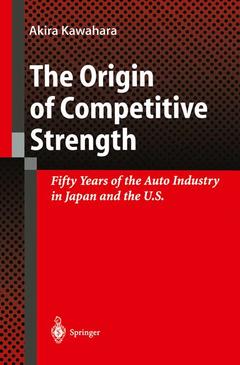Description
The Origin of Competitive Strength, Softcover reprint of the original 1st ed. 1998
Fifty Years of the Auto Industry in Japan and the U.S.
Author: Kawahara Akira
Language: English
Keywords
Japan; USA; control; cooperation; distribution; growth; innovation; joint venture; lean; lean production; management; manufacturing; planning; productivity; trade
Publication date: 02-2012
278 p. · 15.5x23.5 cm · Paperback
278 p. · 15.5x23.5 cm · Paperback
Description
/li>Contents
/li>Comment
/li>
When the war ended on August IS, 1945, I was a naval engineering cadet at the Kure Navy Yard near Hiroshima, Japan. A week later, I was demobi lized and returned to my home in Tokyo, fortunate not to find it ravaged by firebombing. At the beginning of September, a large contingent of the Ameri can occupation forces led by General Douglas MacArthur moved its base from Yokohama to Tokyo. Near my home I watched a procession of American mili tary motor vehicles snaking along Highway 1. This truly awe-inspiring cavalcade included jeeps, two-and-a-half-ton trucks, and enormous trailers mounted with tanks and artillery. At the time, I was a 21-year-old student in the Machinery Section of Engineering at the Tokyo Imperial University. Watching that mag nificent parade of military vehicles, I was more than impressed by the gap in industrial strength between Japan and the U. S. That realization led me to devote my whole life to the development of the Japanese auto industry. I wrote a small article concerning this incident in Nikkei Sangyo Shimbun (one of the leading business newspapers in Japan) on May 2, 1983. The English translation of this story was carried in the July 3, 1983 edition of the Topeka Capital-Journal and the September 13, 1983 issue of the Asian Wall Street Journal. The Topeka Capital-Journal headline read, "MacArthur's Jeeps Were the Toyota Catalyst.
Prologue — The Japanese Automobile Industry Gets on Its Feet.- MITI’s Automotive Strategy in the 1950s.- Rise of Independent Two-Wheeled and Three-Wheeled Vehicle Manufacturers.- The Shelving of the “People’s Car” Plan.- Recognition of the Need to Develop a Car for the Masses.- The First Definition of Productivity, and the Difference between Japan and the U.S.- I. Toyota Moves into the Fast Lane.- I-1. The Big Time — Launching Toyota’s American Operation.- I-2. Fifteen Long Years Establishing an American Base.- I-3. Overtaking the Datsun Bluebird.- I-4. Failure in Introducing an American-Style Distribution System.- I-5. The Product Planning Office at Toyota Motor Sales: Placing the Customer First.- I-6. Corolla vs. Sunny.- I-7. Foresight Behind the Development of the One-Box Van.- I-8. The Shock of My Years with General Motors.- I-9. The Revolutionary Celica Ordering System.- I-10. Development of Distribution Systems.- II. A Flagship Car.- II-1. MITI’s Shadowboxing.- II-2. Grappling with Emission Control Measures.- II-3. Look-Alike Cars: The Hidden Key to Success or Failure.- II-4. The God of Sales: President Kamiya.- II-5. Overtaking the Datsun Bluebird.- II-6. The Lexus.- III. Management of the Automobile Industries in Japan and the U.S. in the Postwar Period.- III-1. Characteristics of the Automobile Industry.- III-2. The Evils of the Big Three’s Oligopoly.- III-3. Comparison of the Management Performance of Toyota and GM in the Postwar Period.- III-4. Conclusion.- IV. The Success of NUMMI.- IV-1. Growing Popularity of Posts in NUMMI.- IV-2. An Unrealized Partnership between Toyota and Ford.- IV-3. Talks Quickly Shift to Toyota and GM.- IV-4. A Strong Desire to Achieve a Joint Venture.- IV-5. The Understanding and Cooperation of the UAW.- IV-6.Universality of the Toyota Production System is Proven.- V. GM’s Tough Fight.- V-1. The Big Three’s Late Comprehension of the Small-Car Market.- V-2. Corvair’s Setback.- V-3. The Vega and the Death of Ford-style Mass Production System.- V-4. Chevette’s Success.- V-5. The Tragedy of the X-Car.- V-6. The Collapse of the J-Car.- V-7. The Rejection of the S-Car.- V-8. The Vision of Saturn.- V-9. Hamtramck Plant Versus Tahara Plant.- V-10. The Key Reasons for Failure.- VI. The Rebirth of GM.- VI-1. Coup d’Etat by Outside Directors.- VI-2. Management Reform Under President Jack Smith.- VI-3. Overhaul of Product Planning.- VI-4. Production Startup Problems.- VI-5. Lean Production.- VI-6. Enhancing GM’s Technological Potential.- VI-7. Independence of Parts Suppliers.- VI-8. The New Purchasing Philosophy.- VI-9. Rebuilding the Domestic Sales Structure.- VI-10. Stepping Up Overseas Operations.- VII. Lean Production and the Challenge to the “World Car”.- VII-1. Ripple Effect of the MIT Study.- VII-2. The Toyota Production System and the Ford Production System.- VII-3. Competition and Production Leveling.- VII-4. GM Europe and Lean Production.- VII-5. World Car’s Conditions.- Epilogue.- The Arrival of the Black Ships.- The Automobile Industry and the Bubble Economy.- Developing the Technology Basis.- Addendum.- Japan-U.S. Auto Trade Negotiations.- Zero-Emission Vehicles.- The Progress of Electronic Science’s Application to the Auto Industry.- Increased Competition of Mini-Cars.- About the Author.- Reference.
This book has deep insights into two leading corporations, Toyota and GM, for comparison and examines the true nature of comeptitive strength not only between Toyota and GM but also among the auto industry as a whole *Total information contained is based on the authors deep involvement in strategic analysis of GM and other auto makers as one of Toyota executives Many factual data and actual experience are contained in this very plain readable book. The author tells how Toyota had become worlds leader in auto industry
© 2024 LAVOISIER S.A.S.




